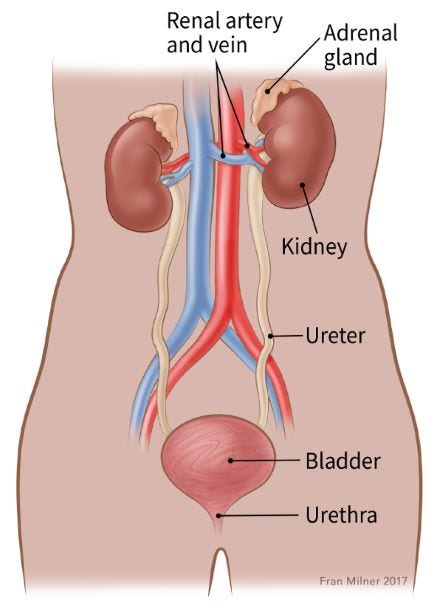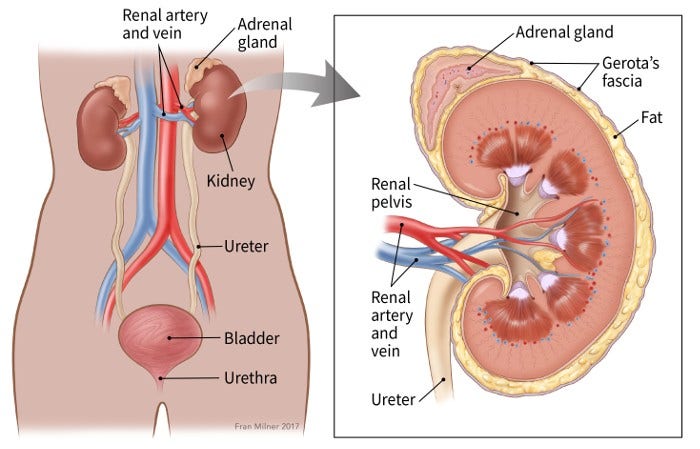Your gift is 100% tax deductible
What Is Adrenal Cancer?
The adrenals are small glands that sit on top of each of the kidneys. The kidneys are located deep inside the upper part of the abdomen.


About the adrenal glands
Each adrenal gland has 2 parts. The outer part, the cortex, is where most tumors develop. The cortex makes certain hormones for the body. These hormones all have a similar chemical structure and are called steroids:
- Cortisol causes changes in metabolism to help the body to handle stress.
- Aldosterone helps the kidneys regulate the amount of salt in the blood and helps regulate blood pressure.
- Adrenal androgens, also called dehydroepiandrosterone or DHEA, can be converted to the sex hormones, estrogen and testosterone in other parts of the body. The amount of these hormones, however, that results from conversion of adrenal androgens is small compared to what is made in the other places in the body. In men, the testicles produce most of the androgens (male hormones). The ovaries produce most of the estrogens (female hormones) in women.
The inner part of the adrenal gland, the medulla, is really an extension of the nervous system. Nervous system hormones such as norepinephrine, epinephrine, and dopamine are made in the medulla. Tumors and cancers that start in the adrenal medulla include pheochromocytomas (which most often are benign) and neuroblastomas.
Tumors and cancers of the adrenal cortex are covered here, but tumors of the adrenal medulla are not. Neuroblastomas are covered separately elsewhere.
Adrenocortical tumors
Many adrenocortical tumors are discovered by accident (incidentally) when CT or MRI scans of the abdomen are done because of an unrelated health problem. These tumors are called adrenal incidentalomas, if the mass is larger than 1 cm (less than ½ inch) and is found incidentally.
Regardless of how they are found, all adrenocortical tumors should be determined to be either:
- Adrenocortical adenomas (Benign or non-cancerous tumors that don’t spread beyond the adrenal gland.)
- Adrenocortical carcinomas (Malignant or cancerous tumors that can spread beyond the adrenal gland.)
In general, the findings on imaging scans can help doctors understand if the tumor is an adenoma or carcinoma, based on the tumor’s size and how it looks (smooth vs. irregular, the lack or presence of fat, etc.).
Adrenocortical adenomas
Most adrenal cortex tumors are benign adenomas. These tumors are usually small (less than 4 cm) and occur in only one adrenal gland. Most people with adrenal adenomas have no symptoms and don't know that they have an adrenal tumor.
Adrenocortical adenomas are categorized by whether they make hormones (functional) or not (non-functional). Most adenomas are non-functional. However, the small percentage of adrenocortical adenomas that do make hormones can cause certain medical conditions, such as:
- Cushing’s syndrome (high levels of cortisol)
- Primary aldosteronism (high levels of aldosterone)
- Androgen and estrogen-secreting tumors
The excess hormones can cause the same symptoms as those from adrenocortical carcinomas (cancers). To learn more, see Signs and Symptoms of Adrenal Cancers.
Treatment: How an adrenocortical adenoma is treated depends on:
- If is causing symptoms, and
- If there are concerning findings on imaging scans
If an adenoma is causing symptoms, either by making excess hormones or by its size pressing against other structures, surgery is considered. Some patients having hormone-related symptoms who can’t have a major operation because of other major health problems, might consider a drug treatment to block the production or actions of these hormones.
Surgery is considered if the imaging scan shows an adenoma has concerning features, such as:
- Size greater than 4 cm (almost 1 ½ inches)
- Relatively low percentage of fat (called lipid-poor)
- Irregular borders and appearance
If an adenoma is not causing any symptoms, is smaller than 4 cm, and has no concerning features on scans, it is generally just watched. Based on the way it looks when the scan is repeated 3 months to 24 months after diagnosis, if the adenoma has gotten larger or is larger than 4 cm, surgery would be considered. If the tumor is unchanged and the patient does not have any symptoms from it, it might not need to be treated at all.
Adrenocortical carcinomas (adrenal cancer)
Tumors that form from the adrenal cortex and can spread to other parts of the body are called adrenocortical carcinomas. They are also called adrenal cancers. Some of the adrenal cancers make excess hormones (functional) and can cause the same symptoms as functional adrenocortical adenomas.
To learn more, see Signs and Symptoms of Adrenal Cancers.
Adrenal cancers that do not make hormones (non-functional) may start causing symptoms when they grow to a certain size and press on nearby structures, causing abdominal pain.
Treatment: How an adrenal cancer is treated depends on:
- If it has spread to other parts of the body
- If the tumor can safely be removed
- If the patient can tolerate surgery
If the cancer has not spread to other parts of the body, the tumor can be removed. If the tumor can safely be removed and the patient can tolerate such a procedure, then removal of the adrenal gland is commonly advised. This procedure is called an adrenalectomy.
However, if the cancer does not meet all the above criteria, then an adrenalectomy is generally not advised. Sometimes, an adrenal tumor may be removed surgically to treat symptoms such as pain or high hormone levels.
If surgery is not an option for you, your doctor may discuss other options such as close observation with no intervention, localized therapy such as radiation or ablation, or enrolling in a clinical trial.
Metastatic cancer in the adrenal gland
Most cancers found in the adrenal gland did not start there and are not primary adrenal cancers. Instead, they started in other organs or tissues and then spread (metastasized) through the bloodstream to the adrenal glands. For example, lung cancers, melanomas, and breast cancers may spread to the adrenals. When other cancers spread to the adrenals, they are not considered adrenal cancer. They are named and treated based on the place where they started.
- Written by
- References

Developed by the American Cancer Society medical and editorial content team with medical review and contribution by the American Society of Clinical Oncology (ASCO).
Lirov R, Tobias E, Lerario AM, Hammer GD. Adrenal tumors In: DeVita VT, Lawrence TS, Rosenberg SA, eds. DeVita, Hellman, and Rosenberg’s Cancer: Principles and Practice of Oncology. 10th ed. Philadelphia, PA: Lippincott Williams & Wilkins 2015: Chapter 84.
Schneider DF, Mazeh H, Lubner SJ, Jaume JC, Chen H. Cancer of the endocrine system In: Neiderhuber JE, Armitage JO, Doroshow JH, Kastan MB, Tepper JE, eds. Abeloff’s Clinical Oncology. 5th ed. Philadelphia, PA. Elsevier: 2014: 1112-1142.
National Comprehensive Cancer Network, Clinical Practice Guidelines in Oncology (NCCN Guidelines®), Neuroendocrine and Adrenal Tumors, Version 2.2024--August 1, 2024. Accessed at https://www.nccn.org/professionals/physician_gls/pdf/neuroendocrine.pdf on July 17, 2024.
Last Revised: October 1, 2024
American Cancer Society medical information is copyrighted material. For reprint requests, please see our Content Usage Policy.
American Cancer Society Emails
Sign up to stay up-to-date with news, valuable information, and ways to get involved with the American Cancer Society.



